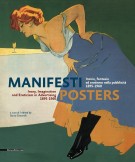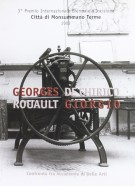Manifesti/Posters Ironia fantasia ed erotismo nella pubblicità 1895-1960 Irony Imagination and Eroticism in Advertising 1895-1960
| Autore/i | a cura di Dario Cimorelli | ||
| Editore | Silvana Editoriale | Luogo | Milano |
| Anno | 2012 | Pagine | 288 |
| Dimensioni | 25x31 (cm) | Illustrazioni | 280 ill. a colori - colors ills |
| Legatura | cart. edit. sovracc. ill. - hardcover with dust jacket | Conservazione | Nuovo - New |
| Lingua | Italiano/Inglese - Italian/English text | Peso | 2800 (gr) |
| ISBN | 8836622526 | EAN-13 | 9788836622528 |
momentaneamente non disponibile
Tra la fine del XIX e la prima metà del XX secolo, nelle strade delle città di un’Italia che si sta aprendo all’era moderna, fanno la loro apparizione – e rapidamente si diffondono – i primi manifesti pubblicitari, eccezionali strumenti di promozione del nuovo “vivere”.
I forti colori, i contrasticromatici, che nascono dal pennello dei grandi illustratori dell’epoca come Cappiello, Mauzan, Dudovich, Codognato, Metlicovitz o Boccasile, catturano l’attenzione di un pubblico sempre più attento ai nuovi prodotti. Il gioco, l’allusione, l’ironia, la sperimentazione – in una parola la fantasia – diventano così caratteristica principale della comunicazione pubblicitaria italiana, che non ha confronti con quanto si va facendo negli stessi anni nella cartellonistica europea e statunitense, confermando così la vitalità e la portata innovativa della creatività italiana. Il volume, introdotto da un testo del curatore, è completato da una bibliografia.
Between the late 19th century and the first half of the 20th, the city streets of an Italy that was opening up to the modern age witnessed the appearance – and rapid spread – of the first advertising posters, outstanding means of promotion for the new “way of living”. The strong and contrasting colours sprung from the brush of great illustrators of the day, such as Cappiello, Mauzan, Dudovich, Codognato, Metlicovitz and Boccasile, caught the attention of a public increasingly interested in new products. Playfulness, allusiveness, irony and a willingness to experiment – in other words, imaginativeness – thus became the distinguishing trait of Italian advertising communication, for which European or American posters of those years were no match: a further confirmation of the liveliness and innovative drive of Italian creativity. (T-CA)
Potrebbero interessarti anche...





